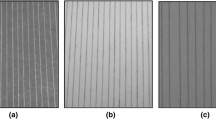Abstract
In accordance with developing technologies in textile and garment industries, innovative products are submitted to the market continuously. Almost each innovative product introduced to the market provides a different functionality to the textiles such as breathability, lightweight, ultrathin etc. Some of the functional designs are turned into commercial products and some of them are still in experimental stage. In this study, it is aimed to analyze the worsted fabrics, which was designed to have higher tensile properties. Within the scope of this study, worsted fabrics produced from wool and high tenacity polyamide 6.6 fibers, which were mixed in the blend, with/without elastane. Compression, extensibility, bending rigidity, shear rigidity, tear strength, breaking strength and abrasion resistance properties of the fabrics were measured. According to the results, the use of elastane in the fabric structure causes an increase in the surface thickness, extensibility, formability of the fabrics, and a decrease in the bending rigidity, shear rigidity of the fabrics. Besides, the fabrics produced in this study have generally high tensile and abrasion resistance performance because of the high tenacity polyamide 6.6.
Similar content being viewed by others
References
R. Paul, “High Performance Technical Textiles”, John Wiley & Sons, Inc., New Jersey, 2019.
S. Rejendran, “Advanced Textiles for Wound Care”, Woodhead Publishing, Cambridge, 2019.
K. Sinnppoo, L. Arnold, and R. Padhye, Text. Res. J., 80, 1083 (2010).
V. K. Kothari and S. Chakraborty, Fiber. Polym., 17, 809, (2016).
P. Mehta, M. Driggers, and C. Winterhalter, “Development of Flame Resistant Combat Uniform Fabrics Made from Long Staple Wool and Aramid Blend Yarn”, Technical Report, American Sheep Industry Association Centennial Co., 2013.
Z. D. Moldagazhiyeva and R. O. Zhilisbayeva, Mod. App. Sci., 9, 334 (2015).
J. Cortez, P. L. Bonner, and M. Griffin, Enz. Microb. Tech., 34, 64 (2004).
P. Varnsverry, “Textiles for Protection”, Woodhead Publishing Limited, Cambridge, 2005.
S. Hussamy, Text. Chem. Color., 25, 47 (1993).
A. De Boos and D. Tester, “SiroFAST: Fabric Assurance by Simple Testing (ReportNo. WT92.02)”, Csiro Textile and Fibre Technology, Geelong, Victoria, Australia, 1994.
A. M. Manich, J. P. Domingues, R. M. Sauri, and A. Barella, J. Text. Inst., 89, 579 (1998).
T. J. Mahar, I. Ajiki, and R. Postle, Int. J. Cloth. Sci. Tech., 2, 5 (1989).
J. Guan, H. Lu, and Y. Chen, J. Eng. Fiber. Fabr, 8, 30 (2013).
P. Shilpa, V. Verma, and M. Gupta, J. Tex. Assoc., 67, 201 (2007).
D. B. Shakyawar, A. S. M. Raja, S. A. Wani, V. V. Kadam, and P. K. Pareek, J. Text. Inst., 106, 327 (2015).
V. S. Goud, Indian J. Fibre Text., 37, 292 (2012).
S. B. Abdessalem, Y. V. Abdelkader, S. Mokhtar, and S. Elmarzougui, J. Eng. Fab. Fiber., 4, 30 (2009).
L. K. El-Gabry, Z. M. Abdel-Megied, and F. S. Ebrahim, J. Bas. App. Sci. Res., 2, 13158 (2012).
K. Doustar, S. S. Najar, and M. Maroufi, J. ext. Inst., 101, 135 (2010).
R. W. Moncrieff, “Man Made Fibres”, Newnes-Butterworths, London, 1975.
A. Taieb, S. Msahil, and F. Sakli, J. Adv. Res. Mech. Eng., 1, 43 (2010).
T. J. Mahar, I. Ajiki, R. C. Dhingra, and R. Postle, Int. J. Clot. Sci. Tech., 1, 6 (1989).
R. Postle, G. A. Carnaby, and S. De Jong, “In The Mechanics of Wool Structures”, Chichester, West Sussex: Ellis Horwood, 1988.
P. Varnsverry, “Textiles for Protection”, Woodhead Publishing Series in Textiles, CRC Press, 2005.
Acknowledgments
The author would you like to thanks to employees of Yünsa Worsted & Woolen Production and Training Co. for their helps throughout the study.
Author information
Authors and Affiliations
Corresponding author
Rights and permissions
About this article
Cite this article
Yavuzkasap Ayakta, D., Oner, E. & Celikkiran, S. A Research on the Mechanical Properties of Worsted Fabrics Made of High Tenacity Polyamide. Fibers Polym 20, 2426–2432 (2019). https://doi.org/10.1007/s12221-019-1174-0
Received:
Revised:
Accepted:
Published:
Issue Date:
DOI: https://doi.org/10.1007/s12221-019-1174-0




